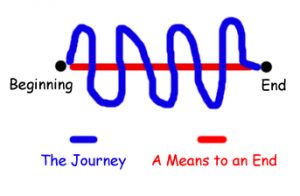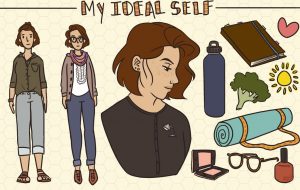Here’s another way you might want to jump into thinking about what is most meaningful to you in your life, and how you can use that to stabilize and anchor yourself when you are being tossed about in the storms (and even occasional hurricanes) of life. I call it THE THREE DIMENSIONS OF VALUE*.
If you haven’t read my initial post on this, you might want to do that before you jump in. Otherwise, please have a look at the guidelines below.
THE FIRST DIMENSION OF VALUE: LIKE/DISLIKE
 The first dimension of value is the default dimension, which is to say our mind’s default approach to life. This value is based on liking and not liking. One of the fundamental tasks of our mind is to process experiences and decide which of those experiences are enjoyable, painful, or neutral. Our minds do this because it makes sense from an adaptive, evolutionary perspective to guide us towards doing things that we enjoy and may benefit from, as opposed to those thing that may not contribute to our success. The way our minds do this is by either assigning the experience of “good“, “bad“, or “neutral” to anything we do. Anything and everything. Every emotion we have, every bodily sensation we experience, every possible action that presents itself in the mind as a plan.
The first dimension of value is the default dimension, which is to say our mind’s default approach to life. This value is based on liking and not liking. One of the fundamental tasks of our mind is to process experiences and decide which of those experiences are enjoyable, painful, or neutral. Our minds do this because it makes sense from an adaptive, evolutionary perspective to guide us towards doing things that we enjoy and may benefit from, as opposed to those thing that may not contribute to our success. The way our minds do this is by either assigning the experience of “good“, “bad“, or “neutral” to anything we do. Anything and everything. Every emotion we have, every bodily sensation we experience, every possible action that presents itself in the mind as a plan.
You can test this out by asking yourself at this very moment what your mind thinks about this article so far? Is it finding it stimulating or enjoyable (i.e. interesting enough, rewarding enough for your mind)? Or maybe, at this point, it’s finding it a tad dull, or not-so-enjoyable (your mind is not learning anything new, not having its interest piqued enough in order to continue reading)? Or does your mind feel neutral towards reading these words? See if, just until you get to the bottom of this page, no matter what your mind is telling you about the article, either good or bad, you are able to override its thumbs-up/down guidance for 5 or 10 minutes and continue reading. Just in case, there might be something further down of some worth!
As complex as our minds are, on this point they actually very, very simple. Consider this: our mind is only capable of having one of three responses to anything, including this article. Any situation, any perception, any life event. Of course it may be a little bit more of a mixed bag in the experiencing of this: our minds may enjoy some parts of our experience and not enjoy other parts, but I would be very surprised if your mind had no liking or disliking about this article at all, or anything else for that matter. Particularly as that would then just be an example of neutrality!
The “good” experience, or perception, or thought (as in “This feels good, I like this”), usually corresponds to things we like or find pleasurable and rewarding in some way. The “bad” usually corresponds to those things we don’t like or find unpleasant or unrewarding. Neutral is for when we’re not sure, or feel dispassionate about something. For example:
I like clouds.
I don’t like rain.
I am completely neutral towards frost.
The quickest way to get a sense of this for yourself is to bring your mind to bear on those three core aspects of your life (work, relationships, you) and make a list of ALL the things you like doing (or experiencing) in those areas, as well as those things you don’t like doing/experiencing in those three areas.
You might also want to pair your likes and dislikes. So when considering the stuff you like, see if there is a “dislike” or a series of dislikes connected to the like. For example:
I LIKE eating healthy, home-cooked food.
I DISLIKE the preparation time required for preparing healthy, homemade food, as well as clearing up afterwards.
I suspect, due to the abundance nowadays of meal-kit food delivery services such as Blue Apron, Mindful Chef, Hello Fresh and a host of others, this is a fairly common dilemma for most of us. Which is not surprising as we all have minds, and this is what minds are like.
Your final like/dislike list may look something like this: https://docs.google.com/document/d/1DHvUqSTwborTZ36RZan9YjTd4xsvkCWMVE_yvJqhdEY/edit?usp=sharing
THE SECOND DIMENSION OF VALUE: BENEFITS AND ENDS
 Now let’s go into the second dimension of value which is the dimension of Benefits or Ends.
Now let’s go into the second dimension of value which is the dimension of Benefits or Ends.
In this dimension, we focus on those things that benefit us in some way or that we might consider to be a means to an end, even if we don’t necessarily enjoy doing them that much.
Certain forms of exercise I think are a good example of this. Taking oneself off to the gym, or going for a run, or doing some HIIT or yoga at home takes effort, both in the preparation and execution of the valued activity.
Sometimes we are only willing to do these effortful activities because the thing we don’t like benefits us in some essential way (we like the ends, but not the means to that end). Doing the activity then becomes a classic example of a means to an end: we can see how our effort benefits us in terms of mood, general life-satisfaction, finances, or physical health, even though we really don’t enjoy doing the thing that results in these gains.
People often put work-related activities into this category. But if you think about it, there are a number of things in our lives that are not especially enjoyable, but we try and make sense of them, tolerate and accept them, only because we are able to remind our complaining minds that they are a means to an end. Go to the dentist, get a lollipop (and cavity-free teeth).
In order to explore this dimension, I would suggest placing some of the things from your list of things that you don’t like (in work, relationships, and your experience of yourself) into this value dimension where you might be able to both recognise and eventually experience these phenomena as “necessary evils”.
You may also want to make a note of how you benefit from doing those things you don’t like.
If you’ve set up your lifestyle LIKES and DISLIKES list as I have done here to show how everything we like has both costs and benefits (like the benefits, don’t like the costs), the necessary evils should at this point be quite clear to you. If so, you may want to ask yourself: do I value this thing I like enough in my life to put in the effort to have it? This would also be a good thing for us to look at and talk about in one of our sessions.
THE THIRD DIMENSION OF VALUE: IDEA(L)S & ASPIRATIONS
 The third dimension, is the dimension of aspirations, of Ideas and Ideals.
The third dimension, is the dimension of aspirations, of Ideas and Ideals.
This is where you write down all the ways you would like to be, and sometimes are, but maybe not as much as you would like to be. We all have an idea(l) self who is usually acting in our minds, or in projected futures, in ways that we often fail to match.
My reason for bracketing off the L in the word IDEA(L) is to remind us that our IDEALS are also, always, IDEAS. That is to say: when we think about an IDEAL, it seems to tangible to our minds, which is of course where the IDEAL resides (there and nowhere else), both in how it beckons as an alluring possibility, as well as taunts us as an impossibility, even we feel that its attainment might take a lot of work.
Consider this: any idea we have of ourselves framed as an IDEAL (“I’d really like to be this way, but alas I’m more than often not!”) is also an IDEA, a concept in our heads until it gets realised. We may for example have an IDEAL idea of the job we might do (less meetings and reports, more creative projects et cetera) even whilst recognising that our wiggle room in this sphere is quite limited. Ideals motivate us, but they can also crush us by pointing out the gap between our rosy possible lives and our sometimes less-than-rosy, but more down-to-earth ways of being and living.
Again, in exploring this third dimension, I would focus here on all three areas of your life:
1. YOU: the kind of person you want to be, both in terms of how you speak and act towards yourself and your own internal world.
2. WORK: the kind of job you’d like to have, or the ideal version of the job you already have.
3. RELATIONSHIPS: the kind of person you want to be with your family, your partner, your friends, your colleagues, and your boss -not an ideal boss, perhaps a very real, pain in the arse boss- and maybe even here as a citizen, and inhabitant of the place where you live.
To get you going on this, I would suggest filling out the following sentence stems.
Ideally, as a person, I would be more… (list all the ways in which you would like to be, ideally more of something (for example kinder, more patient with challenging people et cetera)
Ideally, as a person I would like to be less…(list all the ways in which you would like to be, ideally less of something, for example less grumpy when things aren’t going my way, less intense and sensitive about stuff et cetera)
Ideally, with my partner, I would like to… (List all the things you would like to do more of as well as all the things you would like to do less of; perhaps also list some general qualities you would like to embody in your day-to-day interactions with this person)
Ideally, when it comes to myself and how I am towards myself when I am feeling either anxious, or depressed, or upset about something I’d like to be more…and less…I’d like to do these things when I feel this way [LIST], rather than these things [LIST],
Ideally, in my work environment I would like to be more… And less…. I would like to do more… And less…
You can add other IDEA(L)S to the list above using the same sentence construction. I would do this just to re-mind your mind each time (for it often forgets this) that the IDEA(L) is just as intangible as the LIKE/DISLIKE dimension, in that they are all mental constructs and words, until we actually put them into action in some way.
The reason our minds don’t focus on putting things into action, but prefer to focus on mental constructs, is that putting stuff into action takes time, energy, effort, and maybe other resources as well and the human mind is by its very nature an energy-conserving entity. Your mind and my mind would far prefer to have some interesting, motivating, why-don’t-you-do-this, why-don’t-you-do-that thought than actually do anything. We’re all dreamers in this way. Don’t be hard on your mind though, it’s not being lazy, it’s just that having thoughts and plans, and even beating ourselves up for not accomplishing those thoughts and plans, costs us nothing in terms of energy. Doing stuff however, especially stuff that may (as all stuff) either succeed in some way or fail in some way, and usually both at the same time, always costs us something. Doing stuff costs us time/energy/attention, and it also involves sacrifice, because in doing stuff we often lose out on the potential gains of doing-something-else.
IDEA(L)S can be so alluring however, and are always worth exploring. If they can be adequately harnessed, they can become incredibly powerful forces in our lives, both in how they contribute to our physical and mental well-being, but also in how they torment us.
IDEA(L)S give us hope for something better or more interesting/stimulating/pleasurable to come. But they also assail us and harangue us when we’re falling short of our IDEA(L)S. And mark my word: we are always falling short of our ideals, all of the time. How could it be otherwise?
—
*I am very grateful to Robert Kane, whose excellent lecture series Quest for Meaning: Values, Ethics, and the Modern Experience, as well as his book Ethics and The Quest for Wisdom conceptualised for me the three dimensions of value, which I’ve tried to utilize for therapeutic purposes above.
